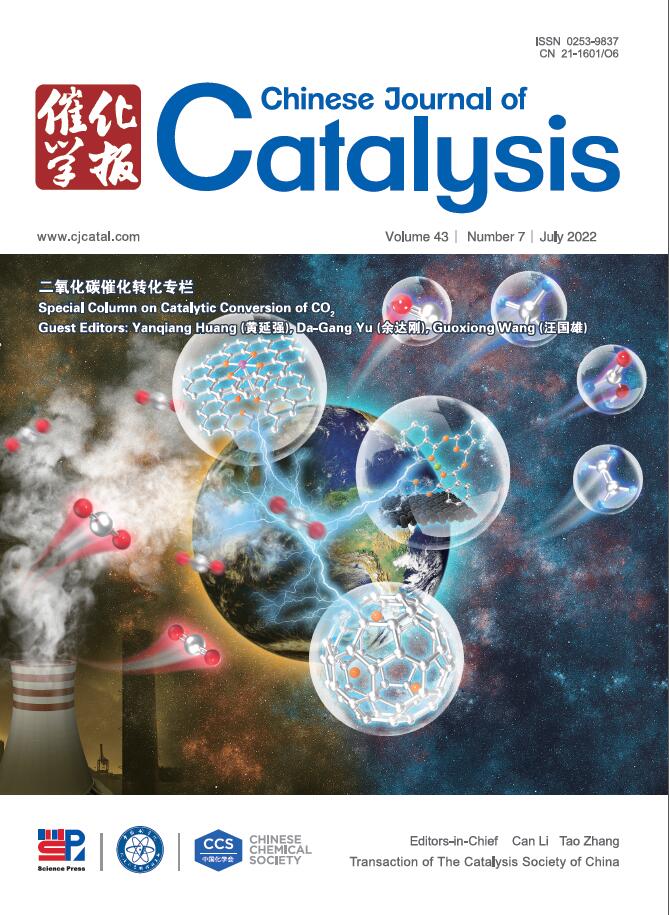从MWW型沸石中简单去除框架铝,获得前所未有的最佳mo浸渍催化剂:系统阐明焦炭沉积及其对甲烷脱氢芳构化的影响
IF 17.7
1区 化学
Q1 CHEMISTRY, APPLIED
引用次数: 0
摘要
在本研究中,我们研究了Mo-浸渍H-MCM-22催化剂(Mo/M)用于甲烷脱氢芳构化(MDA)生成苯和甲苯(BT)等芳烃。我们试图通过水热脱铝来减少H-MCM-22载体的Brönsted酸位(BAS)的数量,从而提高MDA催化剂的性能。在所制备的催化剂中,对H-MCM-22载体进行400℃的最佳水热处理(HT),然后进行Mo浸渍(Mo/M_400),可以使BAS的数量减少且达到最佳,并且Mo的分布与Mo/M相当。此外,Mo/M_400提高了BT的形成速率(Mo/M的最大BT形成速率为5.23,而Mo/M的最大BT形成速率为4.73 mmbt·g−1·h−1);脱铝诱导的BAS数量减少改变了它们与活性Mo物种的空间相互作用,促进了BT和萘的形成。有趣的是,Mo/M_400也提高了中间C2(乙烷和乙烯)生成的寿命。严格的焦炭分析表明,芳香选择性10元环(10-MR)孔中焦炭含量的降低,以及12-MR孔在更长的反应时间内容纳焦炭沉积的能力,提高了Mo/M_400的稳定性。然而,对于所有催化剂来说,BAS的失活以及随后的活性Mo位点的失活主要归因于焦炭沉积。Mo/M_400对MDA性能的整体增强归因于优化还原的BAS的优势,使其性能优于先前报道的Mo基催化剂。本文章由计算机程序翻译,如有差异,请以英文原文为准。
Simple removal of framework aluminum from MWW type zeolites for unprecedented optimal Mo-impregnated catalysts: Systematic elucidation of coke deposition and its impact on methane dehydroaromatization
In this study, we investigated Mo-impregnated H-MCM-22 catalysts (denoted Mo/M) for methane dehydroaromatization (MDA) to produce aromatics such as benzene and toluene (BT). We attempted to improve the performance of the MDA catalysts by reducing the amount of Brönsted acid sites (BAS) of the H-MCM-22 supports via hydrothermal dealumination. Among the prepared catalysts, an optimal hydrothermal treatment (HT) of H-MCM-22 supports at 400 °C, followed by Mo impregnation (denoted Mo/M_400), resulted in a reduced and optimal amount of BAS, along with a comparable Mo distribution to Mo/M. Further, Mo/M_400 enhanced BT formation rates (maximum BT formation rate of 5.23 vs. 4.73 mmolBT·g−1·h−1 for Mo/M); it appears that dealumination-induced reduction in the quantity of BAS altered their spatial interaction with active Mo species, promoting BT and naphthalene formation. Interestingly, the lifetime of intermediate C2 (ethane and ethylene) formation was also improved for Mo/M_400. Rigorous coke analyses revealed that the decreased coke content in the aromatic-selective 10-membered-ring (10-MR) pores, as well as the ability of the 12-MR pores to accommodate coke deposits over a longer reaction time, improved the stability of Mo/M_400. Nonetheless, for all catalysts, the deactivations of BAS, and subsequently, the active Mo sites were mainly ascribed to coke deposition. The overall enhancement in MDA performance by Mo/M_400 was attributed to the advantages of the optimally reduced BAS, allowing such performance to surpass those of previously reported Mo-based catalysts.
求助全文
通过发布文献求助,成功后即可免费获取论文全文。
去求助
来源期刊

Chinese Journal of Catalysis
工程技术-工程:化工
CiteScore
25.80
自引率
10.30%
发文量
235
审稿时长
1.2 months
期刊介绍:
The journal covers a broad scope, encompassing new trends in catalysis for applications in energy production, environmental protection, and the preparation of materials, petroleum chemicals, and fine chemicals. It explores the scientific foundation for preparing and activating catalysts of commercial interest, emphasizing representative models.The focus includes spectroscopic methods for structural characterization, especially in situ techniques, as well as new theoretical methods with practical impact in catalysis and catalytic reactions.The journal delves into the relationship between homogeneous and heterogeneous catalysis and includes theoretical studies on the structure and reactivity of catalysts.Additionally, contributions on photocatalysis, biocatalysis, surface science, and catalysis-related chemical kinetics are welcomed.
 求助内容:
求助内容: 应助结果提醒方式:
应助结果提醒方式:


